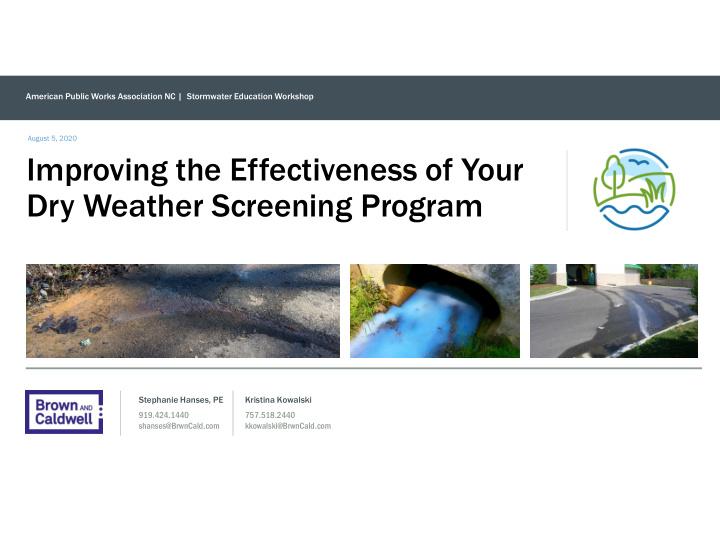



American Public Works Association NC | Stormwater Education Workshop August 5, 2020 Improving the Effectiveness of Your Dry Weather Screening Program Stephanie Hanses, PE Kristina Kowalski 919.424.1440 757.518.2440 shanses@BrwnCald.com kkowalski@BrwnCald.com
Outline 1 Purpose of the Program 2 2 Site Selection 3 3 Site Investigation 4
Purpose of the Program
MS4 Permit Compliance MCM 3: Illicit Discharge Detection MCM 6: Pollution Prevention and Good and Elimination Housekeeping for Municipal Operations
Dry Weather Screening Investigations When? What? • During “dry weather conditions” • Anything other than stormwater • At least 72 hours following >0.1-in of rain • With a few permitted exceptions
Site Selection
Gather your data • MS4 Base Map • Major MS4 outfalls • Receiving waters • Conveyance system • Flow direction • Drainage Areas • Areas greater than 50 acres • Areas with industrial uses greater than 2 acres 7
Establish Criteria • Age and use of residential areas • Older developments • Densely populated areas • Business type classifications • Auto dealers and repair shops • Gas stations and carwashes • Restaurants and catering locations • Shopping centers • Pet facilities • Other criteria • Previous illicit discharges • Known water quality impairments • New construction • Redevelopment/renovation projects
Data Sources • Asset Inventory • Age of pipes and development • Zoning GIS data • Density of development • Industrial and Commercial zones • Planning Department • New construction sites • Redevelopment/renovation sites • Office of Revenue • Business licenses • US Census Data • Density of development • NC DEQ • Impaired waters
Create a Geodatabase
Site Selection Target outfalls with high concentrations of selection criteria Additional sites can be selected • Upstream stations rather than outfalls • Not all discharges may end up at an outfall during dry weather screening
A Case for Upstream Sites
Site Investigation
Site Investigations When you conduct the field visit • Evaluate physical indicators • Chemical analysis for specified parameters • In-field testing • Grab samples for lab analysis
Site Investigations Physical indicators • Discolored water • Dead vegetation • Odor
Site Investigations Physical indicators • Deposits or stains
Site Investigations Physical indicators • Floatables • Debris
Site Investigations Physical indicators • Benthic growth • White (sewage) • Green (algae) • Orange (iron)
Site Investigations Physical indicators • Benthic growth • White (sewage) • Green (algae) • Orange (iron)
Site Investigations Physical indicators • Benthic growth • White (sewage) • Green (algae) • Orange (iron)
Site Investigation - Suds • Detergents • Water with high organic matter will foam when heavily mixed • White foam • Tan or brown foam • Perfume smell • “Earthy” smell
Site Investigation – Sheen • Sheen is not always from petroleum • Natural decomposition by microbes produces oil • Agitation test
Site Investigations Parameters • pH • Turbidity • Temperature • Ammonia • Chlorine • Fluoride • Copper • Potassium
Site Investigations How to test the flow: • Colorimetric chemical analysis • Color wheels • Requires manual interpretation
Site Investigations How to test the flow: • Colorimetric chemical analysis • DR900 • Less inconsistency based on user interpretation • “90 of the most common testing parameters”
Site Investigations How to test the flow: • Supplementary bacteria testing • Laboratory samples • E. coli • Enterococcus
Site Investigations • More data can make More parameters, identifying sources easier • Adding parameters must be more power? done with caution • “Knowing just enough to get you into trouble”
Site Investigations Got a “hit,” then what? • Source tracking • Upstream MS4 network • Tracking chemical and physical indicators • Above ground surveying
Thank you. Questions?
Recommend
More recommend